- Home
- Tove Jansson
Art in Nature
Art in Nature Read online
Art in Nature
Tove Jansson
Translated from the Swedish by
Thomas Teal
For Pentti
Contents
Title Page
Dedication
Art in Nature
The Monkey
The Cartoonist
White Lady
The Doll’s House
A Sense of Time
A Leading Role
The Locomotive
Flower Child
A Memory from the New World
The Great Journey
Copyright
Tuulikki Pietilä’s artwork for the original Swedish publication of Dockskåpet (Doll’s House), 1978, published here as Art in Nature
Art in Nature
Art in Nature
THE SUMMER EXHIBITION grew very quiet when it closed in the evening and the last visitors went away. A little later, boat after boat moved off from the beach and made its way back to the village on the other side of the lake. The only member of staff who stayed overnight was the caretaker. He slept in the sauna down below the great lawn where the sculptures were set out among the trees. He was very old and had a bad back, but it had been hard to find someone who enjoyed the long, lonely evenings, and they had to have a night caretaker because of the insurance.
It was a large exhibition, entitled Art in Nature. Every morning the caretaker unlocked the gates and people streamed into the park. They came in cars and buses from all directions, from the interior and from the capital. They brought their children and made an outing of it. They went swimming among the waterlilies and drank coffee and wandered among the birches, the children rode the swings and had their pictures taken atop the big bronze horse. More and more people wanted to see Art in Nature.
The caretaker was very proud of the exhibition. All day he sat in the huge glass box for painting and graphic arts and watched hundreds of feet go by. Because of his back, he couldn’t see much of their faces, but he observed their feet and made a game of figuring out who they belonged to, what the rest of the person looked like. Sometimes he’d stretch his neck and take a look to see if he’d been right, and often he was. Mostly they were women in sandals, and he could see from their toes that they weren’t all that young.
Almost all the feet moved respectfully. If they were with a guide, they’d stand still for a while, all turned in the same direction, and then they’d change direction all at the same time to look at something else. The lonely feet were uncertain in the beginning, then they’d move slowly at an angle, stop, stand with legs crossed, turn around, and sometimes they’d lift one foot and scratch with it because there were lots of mosquitoes. Then they’d move on, walking rather quickly along the last wall. The caretaker saw lots of feet with sturdy shoes. They’d often stand quite still, then walk along without pausing and then stand still again for quite a long time. He never looked to see what old shoes looked like higher up. Old people’s shoes pointed outward, young people’s inward, and children ran parallel. All of it amused him. One day two old shoes and a cane stopped beside him. He could see that she was very tired.
“Do you know,” she asked, “do you know what number thirty-four is supposed to be? It looks like a package wrapped with string. Are we supposed to open it, or what?”
“I don’t think so,” the caretaker said. “The guide said it was a foreigner who started doing this kind of art and then kept on… wrapping sculptures and then finally a whole mountain. Maybe in Arizona.”
“Is there a chair?” the old woman asked. “This is such a big exhibition.”
He made room for her on the bench beside him and they sat next to each other for a while.
“What I admire”, she said, “is that they come up with so many ideas and then they manage to carry them out and believe so strongly in what they do. I’ll come back another day and look at the sculpture. You can’t take in an exhibition like this one all at once; you have to take it very slowly.”
The caretaker said he liked the sculptures best.
They grew up out of the grass, huge dark monuments in smooth incomprehensible formlessness or in tangled convulsions, challenging and disturbing. They stood everywhere among the birches as if they’d sprung up from the soil, and when the summer night arrived and the mist drifted in from the lake they were as beautiful as granite crags or withered trees.
Each evening, he would close the gates and continue along the shoreline to put out the fire in the sausage grill and see to it that everything was as it should be. He’d replace the moss that children had pulled off the big rocks, and he’d collect the coins from the wishing well and lay them out on a newspaper to dry. He’d check to make sure none of the ashtrays were burning, then empty them carefully into the open, sculptural oven. The June nights were quiet and the lake motionless, with a mirror image beneath each little island. The guard loved his repeated evening strolls, closing for the night. At the gate there was a smell of hay and fertilizer from the farms all around. Along the shore was the smell of mud and grass, then the sauna with its smell of wet soot, and when he walked by the sculptures made of plaster he could smell tar. All of them were impregnated with tar to protect them from the rain. He’d helped to paint them himself. During the day, he didn’t notice the smells; he heard only voices and feet. The caretaker liked the evenings and the nights. He didn’t need much sleep and often sat by himself in the peace and quiet of the lake shore for hours. He didn’t remember, he didn’t worry, he just was. The only thing that troubled him was that the exhibition would close in the autumn. He’d grown used to it and couldn’t imagine another kind of life.
One evening he was making his rounds of the area as usual. He had closed the gates, and everything should have been shipshape. Then he smelled smoke, smoke from something burning. He was beside himself. Fire. Something was on fire! Half stumbling, he tried to run, a few steps in one direction, a few in another, until he realized that the smoke was only coming from the sausage grill. Intruders had hidden somewhere on the property and had now begun grilling sausages down by the lake. Relief made him furious. He headed off across the lawn down towards the shoreline as fast as he could go, but he tried to walk quietly. Soon he heard voices, a man’s and a woman’s, and they were quarrelling. The caretaker snuck closer and looked at them. They were middle-aged adults who should have known better than to break the exhibition rules. The man looked pale. He was wearing an American shirt and had a salmon fly in his hat. The woman was rather fat and wearing an outfit printed with little flowers. They were grilling sausages and drinking beer, and they were arguing. The guard listened for a while. It was a perfectly ordinary domestic quarrel. Then he strode forward, struck the ground with his cane and shouted, “This is outrageous! You can’t have a fire here after closing. It’s absolutely forbidden! When we’re closed, we’re closed. What are you doing here?”
“Good heavens,” the woman said. “Albert, I told you we shouldn’t.”
The man jumped up and was going to pour lake water on the grill, but the caretaker yelled, “Stop that! You’ll crack the grill. It has to burn out by itself!” Suddenly he was very tired and sat down on a rock. The man and the woman were silent.
“Responsibility,” the caretaker said. “Does the word mean anything to you? Do you know what it means? Every night I’m responsible for this whole enormous exhibition, and for the woods, as well. There are works of art here by the country’s finest artists, and it’s all on my shoulders.”
“Svea,” the man said, “give him a sausage and a glass of beer.” But the caretaker turned it down. He didn’t want to be placated. The evening had faded into a summer night, and a light mist came gliding in over the lake and hid the islands. The trunks of the birch trees grew whiter.
“Perhaps I should introduce myself,” the man said. “Fagerlund.”
“Räsänen,” said the guard.
The woman started packing up her baskets. Clearly they couldn’t go on eating and drinking.
“And what is that?” Räsänen asked, pointing his cane at a brown parcel they had put down on a rock. The woman explained quickly that it was a work of art they had picked out and paid for. It was the first painting they had ever purchased and so of course they had to celebrate. “It’s a silkscreen,” she said.
“That’s no excuse,” Räsänen said. “Anyway, the correct name is serigraph. They make lots and lots of copies, but it counts as art anyway. What’s it of?”
“It’s abstract,” Fagerlund said. “But we think it’s two chairs turned a little away from each other.”
Räsänen said that he couldn’t recall any such chairs, and then the wife said it had been furthest in on the right, two perfectly ordinary kitchen chairs in front of some wallpaper. She spoke eagerly and it was clear she was trying to ingratiate herself.
“You’re wrong,” her husband said. “They’re folding chairs, the kind you can whisk out of the way in a second. And anyway, they’re not important. It’s the background that’s important.” He turned to Räsänen and said, “You see, it opens out. You can see life going on outside. It could be a big city. It’s certainly not kitchen wallpaper!”
His wife laughed and said, “You and your big ideas. It’s wallpaper – anyone can see that. Don’t be an ass. They were sitting in their chairs and now they’ve gone and they kicked the chairs apart as they left. Maybe they quarrelled. What do you think? Did they quarrel?”
“They probably just got tired,” Fagerlund said. “They got sick and tired and went out.”
“Yes, of course,” she said. “One of them went to the bar around the corner.”
Räsänen waited a while and then he said how it’s funny about art. Each person sees what he sees, and that’s the whole idea. But why hadn’t they bought something prettier and easier – a landscape, for example?
They didn’t answer. The wife had turned away towards the lake and she was wiping her eyes and blowing her nose.
The caretaker said, “Or you could do this. Since a piece of art can be just about anything, and since we only see what we want to see, you could just not unwrap it and hang the package on the wall. Then you won’t need to argue.” He poked the coals with his cane. The fire was almost out.
After a while she said, “How do you mean, the package?”
“I mean with the paper and the string and everything. You saw some picture packages like that in the exhibition, that’s one of the things they do these days. Maybe you should just imagine what’s inside, and then imagine different things.”
She looked around at him and said, “Are you being serious?”
Fagerlund said, “Svea, Herr Räsänen is teasing you. We should go.”
She turned and started grumpily gathering up their baskets and sweaters and all the rest of their things.
“Wait a minute,” the caretaker said. “I’m perfectly serious. It occurred to me just now. You just need to make the wrapping a little prettier, use more string, you know, fishing line or shoemaker’s thread. Lots of string. I’ve seen how it should look.” He drew a picture in the sand with his cane. “Like this and this. Very carefully. And cover it with glass.”
“But that was expensive!” she burst out. “Anyone could make a package like you’re talking about at home and just hang it up on the wall!”
“No,” said the caretaker. “I don’t think they could. Because then there’s nothing mysterious about it.” He was happy, almost elated at finally grasping the point of the wrapped art. “Now you can go home,” he said. “You’ll have to climb over the gate, because I don’t fancy walking all the way back to unlock it.”
“Albert,” she said, “you’ll have to carry the package.” She gave it a look as if it were about to burst into flames.
Fagerlund picked up the package and put it down again. “No,” he said. “We’ll unwrap it here and now. We’ll let Herr Räsänen decide what it’s a picture of.”
Then she shouted, “Stop that!” and started to cry in earnest and said she didn’t want to know, she just wanted to see it her own way and not be intimidated.
The caretaker was silent for a moment, then he said, “It’s too dark. We couldn’t see anything anyway.” He stood up and said goodbye to his guests. When they’d gone, he sat down again and watched the grill for a while, then he walked slowly back among the sculptures, which now, at the darkest hour of the summer night, were nothing but shadows with clearly defined shapes. But what I said was completely right, he thought. It’s the mystery that’s important, somehow very important. He went and lay down in the sauna with its four bare walls. It was nice to look at them and fall asleep without all the humdrum thoughts he was used to.
The Monkey
THE NEWSPAPER CAME at five o’clock, as it did every morning. He switched on the lamp by his bed, got into his slippers, and shuffled very slowly across the slippery cement floor, taking his usual route among the modelling stands, their shadows black as holes. He’d polished the floor after the last plaster casting. The wind was blowing, and the streetlight outside his studio made the shadows swing, driving them apart and pulling them together again. It was like walking through woods in a moonlit storm. He liked it. The monkey was awake in her cage, hanging on the bars, whining ingratiatingly.
“Bloody monkey,” said the sculptor and went out into the front hall to pick up his paper. On his way back to bed he opened the cage door and the monkey ran up his arm and clung firmly to his shoulder. She was shivering. He put on her collar and attached the leash to his wrist. The monkey was an ordinary guenon from Tangier that someone had bought cheap and sold dear. Every now and then she came down with pneumonia and needed penicillin. The kids in the neighbourhood knitted sweaters for her.
He got back into bed and opened his paper. The monkey lay quietly warming herself with her arms around his neck. After a while, she sat down in front of him, her pretty hands crossed over her stomach, and stared steadily into his eyes, an expression of perpetual, sad patience on her narrow grey face. “Stare away, you damned orangutan,” the sculptor said and went on reading. At the second or third page, the monkey would suddenly and with lightning precision jump through the newspaper, but always through the pages he’d already read. It was a ritual – the paper was ripped to shreds, the monkey shrieked in triumph and then lay down to sleep. It could be liberating every morning at five o’clock to read through all the world’s worst shit and then have the shittiness confirmed by seeing it all shredded and rendered unreadable. She helped him dispose of it. Now she jumped. “You bugger,” said the sculptor. “You cretinous old flea circus!” He invented new insults every morning. He stuffed her in under the quilt to sleep and made sure she had air.
The monkey began to snore and he turned to the arts column. He knew they’d pan his new show, but he found instead a patronizing generosity that he hadn’t expected. He was so old they had to be kind. Without the monkey, he’d have turned to the arts column at once, but she helped him to read it in passing as if it were just another page. “Sleep, you little bastard,” he said. “You’re too dumb to understand. All you care about is getting attention. And breaking things.” It was true: the monkey was like all the rest of them. The tiniest crack, the least stain or defect and her fingers were there to make it worse and pick it apart. She noticed everything, every tiny sign of weakness, and that’s where she’d bite and rip and tear. That’s the way monkeys are, but they don’t know any better and so we forgive them. The others are unforgivable.
The sculptor dropped the newspaper on the floor and turned towards the wall. When he woke up, it was much too late and he got out of bed with the usual awful feeling of having wasted time. He was very tired. First he put the monkey in her cage. She didn’t move, just sat in one corner, her back very narrow i
n its hand-knit sweater. There was heavy traffic on the street outside, and the elevator was running nonstop. He rinsed out some clay rags and swept the floor. It’s easy to sweep polished cement, a long brush that gets in between the legs of the modelling stands and glides across the floor like silk, then into the dustpan and into the trash. He liked sweeping.
Out of habit, he went to the window a couple of times, but he could no longer see out because it was covered with plastic to soften the light. He fed the monkey. He decided to change his sheets and considered dragging the plaster box out into the courtyard but decided against it and did a little more sweeping instead. He collected some old scraps of soap too small to get a grip on, dropped them into a jar and poured in water. He took the clay rags from the statuette and looked at it, swung the top of the modelling stand halfway round and back again. He walked over to the monkey cage and said, “You old carcass, you’re so ugly you make me sick.” The monkey screamed a challenge and stuck her hands out through the bars.
He called Savolainen, but hung up before anyone answered. For that matter, he might as well go eat and get it over with. He decided to take the monkey with him to give her a little change of scenery. But she didn’t want to go, just threw herself back and forth from one side of the cage to the other. “Okay, what do you want?” he said. “Do you want to come out, or do you want to stay here in this mess?” He waited. Finally she came out and sat quite still while he put on her catskin coat. When he tied her cap under her chin, she raised her face and looked at him, a straight, expressionless gaze from yellow eyes placed close together. The sculptor looked away, suddenly upset by the unmoving animal’s attitude of absolute indifference.
They went out together and he held her inside his coat. The wind was still blowing. Some youngsters were hanging around on the esplanade, and when they caught sight of him they came running, shouting, “It’s the monkey! It’s the monkey!” She jumped out of his coat and rushed back and forth on her leash, screaming at the boys, who hollered back and followed the two of them to the corner. There she bit one of them, a quick, sharp bite. “Shitty monkey! Shitty monkey!” the children chanted. He hurried into the café and put the monkey on the floor.

 Comet in Moominland
Comet in Moominland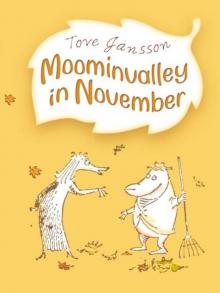 Moominvalley in November
Moominvalley in November Moominland Midwinter
Moominland Midwinter Moominpappa's Memoirs
Moominpappa's Memoirs Sculptor's Daughter
Sculptor's Daughter The Listener
The Listener Tales From Moominvalley
Tales From Moominvalley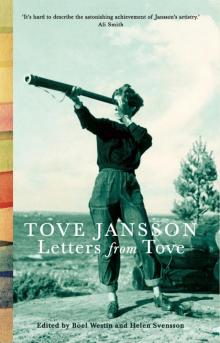 Letters from Tove
Letters from Tove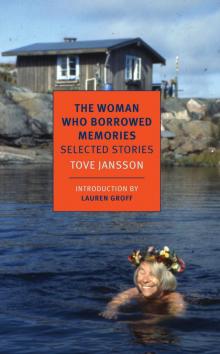 The Woman Who Borrowed Memories: Selected Stories
The Woman Who Borrowed Memories: Selected Stories Travelling Light
Travelling Light Finn Family Moomintroll
Finn Family Moomintroll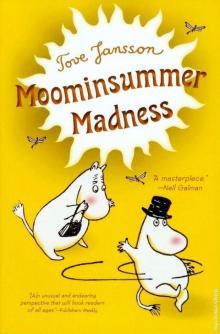 Moominsummer Madness
Moominsummer Madness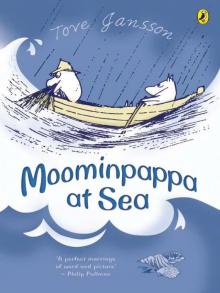 Moominpappa at Sea
Moominpappa at Sea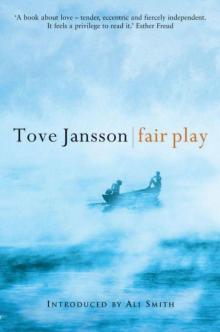 Fair Play
Fair Play Letters From Klara
Letters From Klara Art in Nature
Art in Nature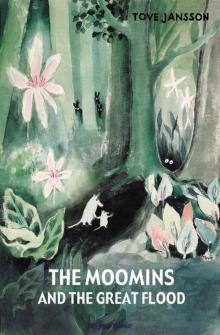 The Moomins and the Great Flood
The Moomins and the Great Flood The Exploits of Moominpappa
The Exploits of Moominpappa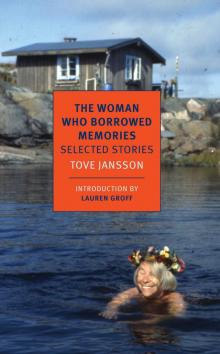 The Woman Who Borrowed Memories
The Woman Who Borrowed Memories